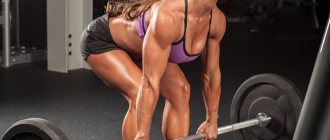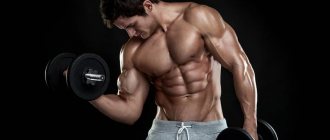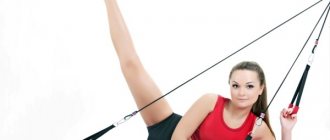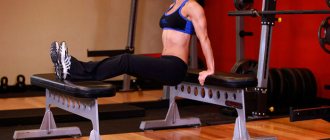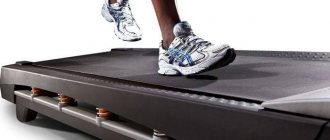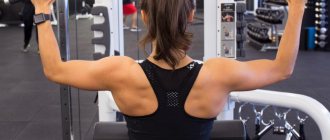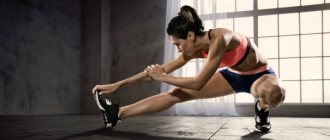The following 15 triceps exercises for men (with accompanying videos) focus on developing the triceps, the large muscles at the back of the upper arm. In fact, girls can use them in their training, the difference will only be in the working weights and drawing up a training program.
Select any exercise to watch the corresponding video. At the end of the article you will find 3 triceps training programs, as well as links to articles about other muscles. The exercises that will be discussed are grouped in the following order:
- Barbell exercises;
- Exercises with dumbbells;
- Exercises in a block simulator;
- Exercises using your own weight;
- Exercises in other simulators.
The Best Triceps Exercises for Men
Triceps exercises with barbell
Bent barbell press (EZ bar)
The triceps barbell press is a good exercise for gaining muscle mass that can be performed either sitting or standing. If you have lower back problems, a sitting position is preferable. This exercise works all parts of the triceps and is usually performed with an EZ bar, although a regular bar will work too. For more emphasis on the triceps, use a grip close to medium. Don't use a too narrow grip as this can put stress on your elbows. Reduce the working weight if you cannot perform the exercise without placing your elbows out to the sides.
Lying arm extension with EZ bar
The EZ bar curl is one of the easiest triceps exercises to build muscle and strength. This exercise works all the muscles of the triceps, but it is especially effective for working the upper part of the triceps. Due to the specific positioning of the elbows in this exercise, too much weight or improper technique can lead to elbow injury. If you are experiencing pain in your elbows, then keep your shoulders at an angle to your torso rather than perpendicular to it, and do not allow your elbows to roll out to the sides during the exercise. Small movements of the elbows are considered normal and acceptable. Small movements of the elbows are considered normal and acceptable.
Goal 4: working out the lateral head
The largest of the three heads, the lateral one, is the farthest from the center and forms the outer contour of the arm. Shifting your focus to the lateral head is a great way to add variety to your triceps training or tighten up a lagging triceps muscle.
You can work the outer head with multi-joint or single-joint movements, but exercises that keep your arms close to your sides, especially with an overhand grip, work best for this purpose.
Explanation of the training.
- Warm-up sets do not count; do them as much as necessary, but never bring them to muscle failure.
- Choose a weight that allows you to reach failure within your intended rep range.
- If you have a partner, do some forced reps on your heaviest set(s) on the first two exercises. If you don't have a partner, get close to muscle failure and use drop sets on the last set of each exercise.
Lateral head of triceps training
- Close grip bench press - 3 sets of 8 reps (rest 60-90 sec.)
- Dips - 3 sets of 10 repetitions, during movement try to avoid leaning your torso forward and make sure that your elbows do not go to the sides (rest 60-90 sec.)
- French press with EZ barbell on a reverse incline bench - 3 sets of 10 reps (60 sec rest)
- Bent-over dumbbell lifts - 3 sets of 12 reps (rest 60 seconds)
Read also: 5 tips for pumping up big biceps.
Triceps training programs
Triceps workout #1
| Exercise | Number of approaches | Number of repetitions |
| 1. Close grip bench press | 4 | 10-12 |
| 2. Reverse push-ups | 4 | 20-25 |
Triceps workout #2
| Exercise | Number of approaches | Number of repetitions |
| 1. Arm extension with EZ bar | 3 | 12 |
| 2. Extension of arms on the upper block with a rope | 3 | 12 |
| 3. Pulling your arm back with a dumbbell | 3 | 15 |
Goal 1: Total triceps mass.
Just because you train your arms doesn't mean your approach to building muscle mass has to change. You should train your triceps the same way you would your chest, legs, back, or shoulders. Start with the most difficult movements that you can use to push the heaviest weight.
Don't even think about looking towards the extensions on the block. As I often write, multi-joint exercises, which involve more than one joint, allow for heavier weights to be used.
With triceps, the list is relatively small, and includes push-ups (parallel bar push-ups, machine push-ups, bench push-ups) and close-grip bench press. If you find it difficult to balance the barbell, try doing presses in a Smith machine.
Read also: How to pump up a woman’s arms: training program.
So, you need to start with multi-joint exercises, but there are a couple more points that you have to take into account when designing your workouts. Because the long head of the triceps (located just above the medial) starts above the shoulder joint, you need to lift your arms overhead to get a full stretch during the movement. A muscle that is not fully stretched cannot contract fully.
To maximize the development of the long head, be sure to include overhead arm movements in your workout. But exercises in the style of hands at the seams are the most “tiring” for the lateral fasciculus, so they should also be included in the training protocols.
To better isolate the triceps and minimize involvement of the deltoids and pecs, do not let your elbows float out to the side during the extension. This rule applies to all triceps exercises. Keep your elbows close to your body as tightly as possible.
Explanations for the workout
- Warm-up sets do not count; do them as much as necessary, but never push your muscles to failure.
- Choose a weight that allows you to reach failure within your intended rep range.
- The first working set (or the first two sets of the first two exercises) is the heaviest, then you reduce the weight to do a little more reps in subsequent sets.
- If you're training with a partner, do a few forced reps on the heavy sets, that is, the first two. If you don't have a partner, get close to muscle failure and use drop sets on the last set of each exercise.
Triceps training for mass
- Close grip bench press - 4 sets of 6, 6, 8, 10 reps (rest 60-90 sec)
- Push-ups in the simulator - 3 sets of 8, 8, 10 repetitions (rest 60-90 seconds)
- Seated dumbbell press - 3 sets of 8, 10, 12 reps (rest 60 sec)
- Reverse grip lat pulldown - 2 sets of 10, 12 reps (rest 60 sec)
The concept of supersets is an effective combination of exercises for different muscles
A superset is an effective approach to organizing strength training. The complex consists of exercises grouped in groups of 2-3. They are performed without a rest break.
There are 2 types of supersets in bodybuilding:
- exercises are grouped to work one part of the body, for example, the chest;
- Several exercises differing in technique and area of influence are grouped.
The back and chest superset has the following benefits for the bodybuilder:
- The duration of the workout is reduced without compromising its productivity.
- Training using the superset program allows you to work with large loads, which makes it possible to intensively strengthen the muscular corset of the back and chest.
- A pumping effect is achieved: muscle tissue during intense training without rest breaks is strongly pumped with blood, stretching its fibers. Due to this, the muscle tissue is qualitatively worked out, acquiring a noticeable relief. The pumping effect leads to muscle volume increasing by 5-10%.
The program described above is suitable for both beginners and advanced athletes. The specifics of the development of the complex will depend on the level of physical fitness of the person.
Important! A complex of intensive back-chest training designed for men. For women who are not professional bodybuilders, supersets are not suitable due to the intense strength loads. Also, excessive pumping of the muscles of the back and chest will lead to disturbances in the proportions of the female figure.
Antagonists
This is the name of the muscles located in parallel. For example, triceps and biceps. According to reviews, experienced athletes with more than a year of experience come to this option: a prepared body is able to withstand loads on large (and small) muscle groups in one day. What to download with what:
- 1 - chest and back;
- 2 - biceps and triceps;
- 3 - legs (quadriceps and hamstrings) and shoulders.
You must work in the order shown. If you swap the first two points, there is a risk that work on the chest and back will be carried out with biceps and triceps that have not fully recovered. This will not provide a thorough workout for a large muscle group and may even lead to injury.
According to reviews from experienced athletes, such a program requires a lot of energy expenditure and recovery time. Therefore, you should use the technique if you have a sufficient amount of endurance.
Frequent option
The standard approach to training is to work on small muscles that are used together with large ones. As usual, the division occurs into three days:
- 1 - legs and shoulders;
- 2 - chest and triceps;
- 3 - back and biceps.
Attention is given to the large group first, then to the small one. When training the chest, push-up exercises are done. The bench press is a lifting of a barbell, the auxiliary muscle is the triceps, because it is responsible for extending the limb.
When thinking about which muscles to train with your back, you should understand that the exercises are of the nature of “pulls”. Whether it's deadlifting or working on a block machine, the arms make flexion movements, so the biceps are involved.
When asked which muscle group is best to train legs with, most stick to the option with shoulders. They do not participate in any way in pumping the lower extremities, but a suitable option for them simply does not exist. If you work your shoulders together with your chest or back, then tired biceps and triceps will not contribute to quality training. The entire bunch of deltas should be pumped in one day.
How to properly train triceps for weight
Pumping up the triceps is a fairly simple task. To get results you need:
- Load the muscle 1-2 times a week.
- Alternate working with different weights (50-60% of 1RM and 70-80% of 1RM).
- Ensure adequate protein intake and calorie surplus.
- Ensure progression of the load and avoid muscle adaptation.
- Allow your muscles to fully recover between workouts.
Combining all the factors, the muscle simply cannot help but increase in size. If, however, athletes do not experience significant growth, especially with regular training, then the reason should be sought in insufficient recovery or nutrition.
Separately, the issue of genetics should be addressed. It will determine the length of the heads and tendons, the shape of the muscles, the ratio of fast and slow fibers and other conditions. Therefore, the rate of muscle growth and volume may differ for different athletes. Based on this, it is important to compare only your own results, making control measurements and tracking strength indicators.
What pumps up the pullover exercise
We were able to find two studies of the pullover using electromyography (EMG), a measurement of the electrical potential in the working muscle.
In one Effects of the pullover exercise on the pectoralis major and latissimus dorsi muscles as evaluated by EMG, scientists found that during a pullover with a barbell, activity in the latissimus dorsi muscles is only 10% of what occurs in the pectoral muscles.
But it won’t be possible to recognize it as one of the best for breast pumping. In another (PDF) Comparison of electromyographic activity during the bench press and barbell pullover exercises experiment, the pullover was compared with the bench press and saw that the latter loaded both heads of the pectoralis major muscles twice as much.
With the lats, the effect was the opposite: the pullover pumps up the back muscles much more than the bench press. But it won’t be possible to recognize it as the best for pumping up the back either, since pull-ups load Surface electromyographic activation patterns and elbow joint motion during a pull-up, chin-up, or perfect-pullup™ rotational exercise on the lats 1.5–2 times more.
The pullover pumps up both the pectoral and latissimus dorsi muscles, but not as well as other exercises.
By the way, there is a theory that it was abandoned precisely for this reason. Since splits—a rigid division of the body into muscle groups—became popular in the field of bodybuilding, it became unclear what the pullover exercise should be classified as. And as a result, it gradually faded into the shadows.
Basic biceps exercises
You can train your biceps at home, but a well-designed training program in the gym will allow you to do this several times faster. So, the main biceps exercises are:
- Lifting the barbell while standing. It is considered one of the most effective. Execution technique: take the barbell with an underhand grip, placing your hands shoulder-width apart. Be sure to make sure that your elbows do not move forward, otherwise it will not be the biceps that will be pumped, but the delta.
- Bending your arms while sitting on an incline bench. When performing the exercise, make sure that your feet are pressed to the floor and your back is against the bench. Alternately bending your elbows, lift the dumbbells. Also make sure that your elbows do not lean forward. In the upper position of your arms, turn your hands towards you.
Both of these exercises should be performed for 2-3 sets, and the number of repetitions depends on the other exercises performed that day.
Lifting the barbell while standing.
This material will be perfectly complemented by the following publications:
- How to pump up your chest on the uneven bars: a set of effective techniques
- Chest training program: split programs from professionals
Is it possible to download in one day?
At the moment, there is an opinion in the field of bodybuilding that during one strength training it is possible to use no more than 2 muscle groups (one of them should be large and the other small). For example, today you train your chest and along with it you train either triceps or biceps. Also, in this combination, it is recommended to place the load on a large group at the beginning of strength training, and then work on a small one. The reasons for this sequence are as follows:
- a large group of muscles requires much more energy;
- When training large muscles, hormonal synthesis is more intense - this has a positive effect on small muscle groups.
The back muscles and triceps fit into this concept, so their one-day training program will be most effective from the point of view of sports physiology.
How to pump up your pectoral muscles
Work on the pectoral muscles.
Experts do not recommend doing more than two chest workouts per week. For beginner athletes, it is enough to perform 2 exercises of 2-3 approaches each. For more advanced athletes, it is optimal to do 6-8 repetitions to increase strength, and 10-12 to build muscle mass.
Advice! Almost all exercises for chest training include the work of the triceps, so when creating a training program. Exercises for the pectoral muscles and triceps should be done on different days.
Let's look at some basic exercises to build up the pectoral muscles:
- Bench press. It is considered the best exercise for beginner athletes. The main advantage is the ability to pump different areas of the chest by changing the inclination of the bench (positive tilt - pumps the upper chest, tilting your head down - pumps the lower area). The number of approaches depends on the training program and on average is 3-4 approaches. You need to do 6-12 repetitions.
Execution technique. Take your starting position on the bench: you need to lie down, pressing your buttocks, shoulders and head to the surface, place your feet on the floor, placing them shoulder-width apart. Take the barbell with a wide grip and lift it up above the center of your chest.
Advice! Be sure to enlist the support of your partner to insure you at first.
We also recommend studying this topic:
How to properly pump up your pectoral muscles: a technique from professionals
14592 0 0
As you inhale, lower the barbell down until it lightly touches your chest, hold your breath. As you exhale, lift the barbell up and hold it in this position, straining your pectoral muscles as much as possible. The barbell should be lowered slowly and raised at a moderate or fast pace.
Performing a bench press.
- Dips. When performing this exercise, most of the muscles of the body are involved in the work: chest-biceps, muscles of the back and shoulder girdle, arms and abdominal muscles of the press.
Execution technique: Take the starting position on the uneven bars with your arms outstretched. This position contracts the muscles and prepares them for stress. You need to tilt your torso forward and slowly lower yourself down while inhaling. After a pause, straightening your arms, as you exhale, slowly rise up. To avoid creating the risk of injury to the elbow joint or pectoral muscle, chest-biceps training should be done slowly.
Important! Watch the position of your elbows: they should be spread out to the sides. Keep them away from your ribs while lifting. This will increase the effect of the exercise.
Performing push-ups on parallel bars.
When performing this exercise in the gym, you should adjust the number of approaches depending on the program. On average, perform 2-3 approaches 6-10 times. Keep in mind that you can only engage the pectoral muscles by going deeply down when performing the exercise. Otherwise, the chest muscles will be used only partially, the triceps will work mainly.
We also recommend studying this topic:
Breast lift using fitness at home
10973 0 1
Readers found these materials useful:
- Push-ups for the upper and lower pectoral muscles
- How to pump up your chest with a barbell: a set of exercises for quick results
